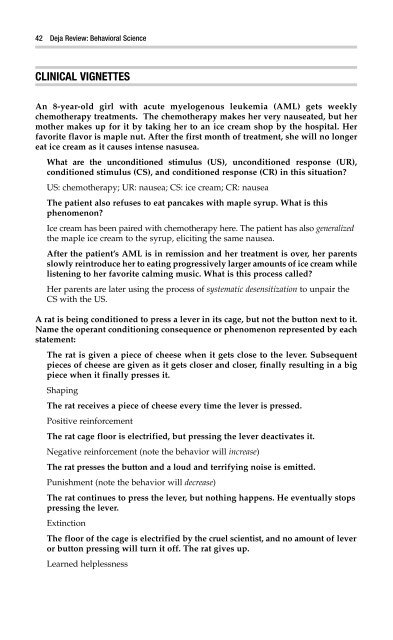Behavioral Science
Create successful ePaper yourself
Turn your PDF publications into a flip-book with our unique Google optimized e-Paper software.
40 Deja Review: <strong>Behavioral</strong> <strong>Science</strong><br />
Where in medicine is modeling used?<br />
Can modeling have a negative outcome?<br />
Can modeling have a positive outcome?<br />
What is habituation?<br />
What is an example of habituation?<br />
How is habituation used in medicine?<br />
How do you describe flooding?<br />
What is an example of flooding?<br />
How do you describe systematic<br />
desensitization?<br />
The common saying, “see one, do one,<br />
teach one,” is a description of modeling<br />
in learning how to do medical<br />
procedures.<br />
Yes. Modeling may occur when a child<br />
models the actions of a parent with a<br />
particular phobia and hence also acquires<br />
the same phobia or perpetuation of<br />
abuse by an abused person.<br />
Yes. Modeling may involve other<br />
types of learning, eg, seeing a role<br />
model/mentor’s behavior achieve<br />
a positive result would then act as<br />
a positive reinforcer (which would<br />
be an example of operant<br />
conditioning).<br />
Habituation occurs when stimulus<br />
presentation results in decreased<br />
responsiveness.<br />
You may notice the hum of the air<br />
conditioner when it first comes on,<br />
but due to habituation, your<br />
awareness of that continual hum<br />
will decrease and you can focus<br />
on your studies.<br />
Habituation is used to overcome<br />
phobias. Some of the specific techniques<br />
using habituation are flooding and<br />
systemic desensitization.<br />
It is excessive presentation of the<br />
stimulus to achieve quick habituation<br />
by preventing escape and forcing<br />
a reduction in the associated<br />
behavior.<br />
One could force an individual with<br />
an obsession about germs to touch<br />
a toilet.<br />
In systematic desensitization, the<br />
patient is gradually exposed to<br />
anxiety-producing situations while<br />
simultaneously teaching relaxation or<br />
anxiety-reducing techniques.



